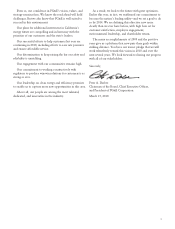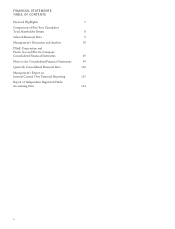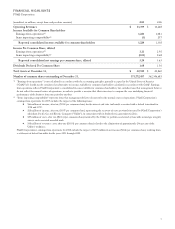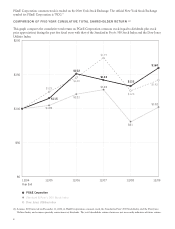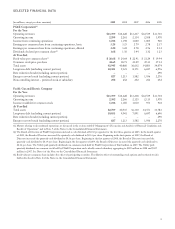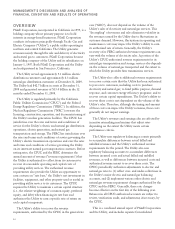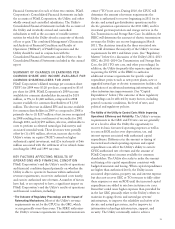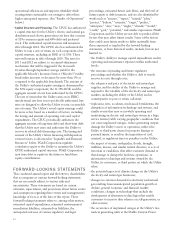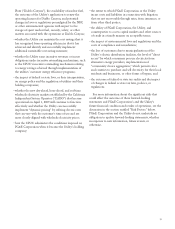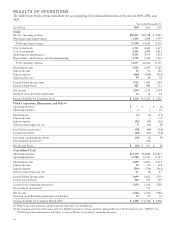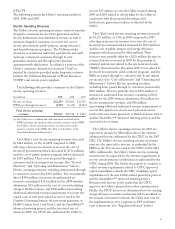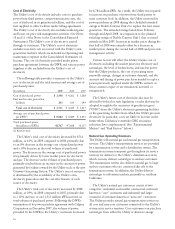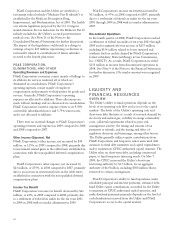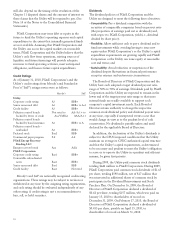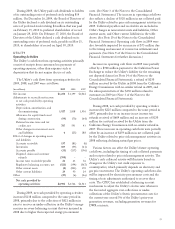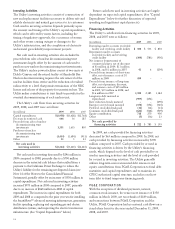PG&E 2009 Annual Report Download - page 19
Download and view the complete annual report
Please find page 19 of the 2009 PG&E annual report below. You can navigate through the pages in the report by either clicking on the pages listed below, or by using the keyword search tool below to find specific information within the annual report.
UTILITY
The following presents the Utility’s operating results for
2009, 2008, and 2007.
Electric Operating Revenues
The Utility’s electric operating revenues consist of amounts
charged to customers for electricity generation and for
electric transmission and distribution services, as well as
amounts charged to customers to recover the cost of
electric procurement, public purpose, energy efficiency,
and demand response programs. The Utility provides
electricity to residential, industrial, agricultural, and small
and large commercial customers through its own
generation facilities and through power purchase
agreements with third parties. In addition, a portion of the
Utility’s customers’ demand for electricity (“load”) is
satisfied by electricity provided under long-term contracts
between the California Department of Water Resources
(“DWR”) and various power suppliers.
The following table provides a summary of the Utility’s
electric operating revenues:
(in millions) 2009 2008 2007
Electric revenues $12,244 $12,063 $11,710
DWR pass-through revenues(1) (1,987) (1,325) (2,229)
Total electric operating
revenues $10,257 $10,738 $ 9,481
(1) The Utility acts as a billing and collection agent on behalf of the
DWR and remits the amounts collected from customers to the DWR.
The Utility’s electric operating revenues are reflected net of the
amounts remitted to the DWR. (See Note 2 of the Notes to the
Consolidated Financial Statements.)
The Utility’s total electric operating revenues decreased
by $481 million, or 4%, in 2009 compared to 2008,
reflecting a decrease in revenues to recover the cost of
electricity procurement (which decreased by $714 million)
and the cost of public purpose programs (which decreased
by $110 million). These costs are passed through to
customers and do not impact net income. (See “Cost of
Electricity” and “Operating and Maintenance” below.)
Electric operating revenues, excluding items passed through
to customers, increased by $343 million. This was primarily
due to $344 million of increases in authorized base
revenues consisting of $103 million for the 2009 attrition
adjustment, $35 million for the cost of a second refueling
outage at Diablo Canyon, and $206 million representing
additional authorized revenue requirements to recover the
capital costs of new assets placed in service (such as the
Gateway Generating Station, the new steam generators at
Diablo Canyon Unit 1 and Unit 2, and the SmartMeterTM
advanced metering project) and the associated rate of
return. In 2009, the CPUC also authorized the Utility to
recover $35 million of costs the Utility incurred during
2000 and 2001 related to efforts taken by the Utility in
connection with the proposed divestiture of its
hydroelectric generation facilities, as directed by the
CPUC.
The Utility’s total electric operating revenues increased
by $1,257 million, or 13%, in 2008 compared to 2007,
reflecting an increase in revenues to recover the cost of
electricity procurement (which increased by $976 million)
and the cost of public purpose and energy efficiency
programs (which increased by $266 million). These
increases were partially offset by a $276 million decrease in
revenue that was recovered in 2007 for the payment of
principal and interest related to the rate reduction bonds
(“RRBs”) that matured in December 2007. Costs related to
electricity procurement, public purpose programs, and the
RRBs are passed through to customers and do not impact
net income. (See “Cost of Electricity” and “Operating and
Maintenance” below.) Electric operating revenues,
excluding items passed through to customers, increased by
$291 million. This was primarily due to $255 million of
increases in authorized base revenues consisting of $103
million for the 2008 attrition adjustment, $56 million for
electric transmission revenues, and $96 million
representing additional authorized revenue requirements to
recover the capital costs of new assets placed in service
(such as the new steam generators at Diablo Canyon Unit 2
and the SmartMeterTM advanced metering project) and the
associated rate of return.
The Utility’s electric operating revenues for 2010 are
expected to increase by $68 million due to the attrition
adjustment that was authorized by the CPUC in the 2007
GRC. The Utility’s electric operating revenues for future
years are also expected to increase, as authorized by the
FERC in the TO rate cases and by the CPUC in the 2011
GRC. Additionally, the Utility’s future electric operating
revenues may be impacted by the revenue requirements to
recover certain pension contributions as authorized by the
CPUC during 2009. The Utility also expects to continue to
collect revenue requirements related to CPUC-approved
capital expenditures outside the GRC, including capital
expenditures for the new Utility-owned generation projects
and the SmartMeterTM advanced metering project.
Revenues will increase to the extent that the CPUC
approves the Utility’s proposals for other capital projects.
Finally, the CPUC has not yet determined how the existing
energy efficiency incentive mechanism will be modified, so
the amount of incentive revenues the Utility may earn for
the implementation of its programs in 2009 and future
years is uncertain. (See “Regulatory Matters” below.)
15


